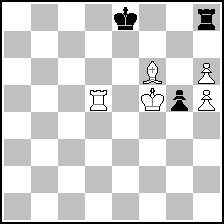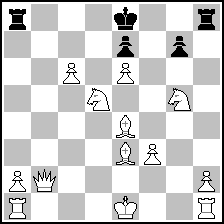
Website founded by
Milan Velimirović
in 2006
5:50 UTC


| |
MatPlus.Net  Forum Forum  General General  Langstaff PRA two-mover Langstaff PRA two-mover |
| |
|
|
|
|
You can only view this page!
| | | (1) Posted by Michael McDowell [Saturday, Sep 27, 2008 20:22] | Langstaff PRA two-mover
A famous problem, frequently quoted to illustrate Partial Retrograde Analysis.
W.Langstaff
The Chess Amateur 1922
 (= 5+3 ) (= 5+3 )
Mate in 2
1.PxPe.p. or 1.Ke6, depending on Black’s last move.
On the numerous occasions I have encountered this problem the source details have always read the same. It was quite a surprise then to find that on its first publication in T.R.Dawson's fairy column in The Chess Amateur for September 1922 (p.377, problem No.239) two names appeared above the diagram, W.Langstaff (London) and C.Stockman (Stockholm). Both names were also mentioned with the solution in the November issue. Somewhere along the line Curt Stockman's name disappeared, leaving William Langstaff with all the credit. Does anyone know why? There appears to have been no further discussion of the problem in The Chess Amateur. Can anyone check sources from the 1920s or 30s to find early republications? It did not feature in the first two volumes of The Problemist, i.e. up to the end of 1941.
| | | (2) Posted by Michael McDowell [Thursday, Jan 15, 2009 20:32] |
I don’t know how I missed it, but the answer was there in The Chess Amateur all the time! Dawson received Stockman’s problem some time after Langstaff’s. Stockman’s setting involved queen’s side castling, requiring an extra black pawn. My guess is that Stockman himself withdrew his name from the credits.
As regards the history of the idea, both Langstaff and Stockman improved on the following:
John Keeble
Norwich Mercury 1902
 (= 7+7 ) (= 7+7 )
Mate in 2
Does anyone know of an earlier example?
| | | (3) Posted by Vladimir Tyapkin [Thursday, Jan 15, 2009 23:52] |
if you are looking for earlier PRA problem, Loyd's N1 from http://www.janko.at/Retros/Glossary/Codex2008.htm should qualify. There is no e.p. though.
| | | (4) Posted by Michael McDowell [Monday, Jan 19, 2009 17:53] |
Thank you Vladimir. I should have been more specific, as it was the particular PRA idea shown by Keeble & Co. that I was thinking of, however it is interesting to consider who first showed PRA. No surprise that Loyd's name should crop up, but I notice that A.C.White's book contains a much earlier example, though it has an odd stipulation and might be considered unsound today.
Sam Loyd
v Missouri Democrat 1859
"A Lesson in Castling"
 (= 13+5 ) (= 13+5 )
Mate in 2 or 3 moves?
If Ra8 has moved mate in 2 by 1.Qxg7
If Rh8 has moved mate in 2 by 1.Qb7
Without reference to previous play, the intention was a mate in 3 by 1.Rg1. However there is a cook by 1.Sh7.
Nowadays of course we would just label it as Mate in 2 (PRA). Or would it be considered unsound because there are two solutions if the king moved last?
| | | (5) Posted by Joost de Heer [Monday, Jan 19, 2009 19:25] |
The situation where the king moved last isn't looked at in PRA. You only have to look at the situations where the maximal number of castlings is possible (in Loyd's case only one in each partial situation). Otherwise all compositions which have castling in them should be labelled PRA and almost all would be cooked if castling were disallowed.
| |
No more posts |
MatPlus.Net  Forum Forum  General General  Langstaff PRA two-mover Langstaff PRA two-mover |
|
|
|
 ISC 2025
ISC 2025 Forum
Forum  General
General  Langstaff PRA two-mover
Langstaff PRA two-mover 


